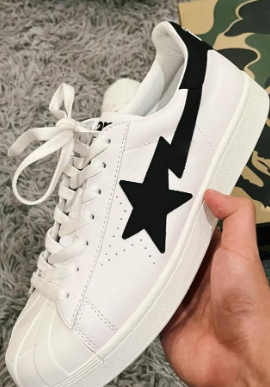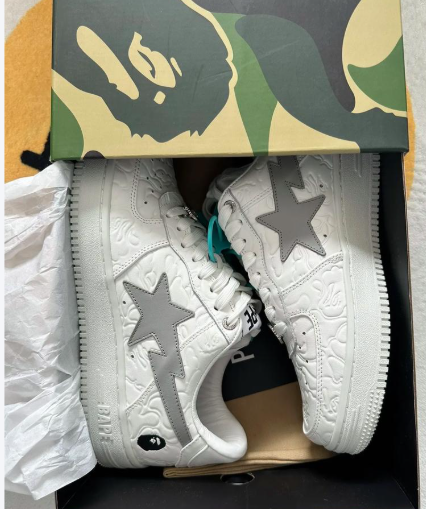A Bathing Ape (BAPE) shoes occupy a distinct niche within the European footwear market, appealing to a specific segment of consumers driven by streetwear culture, brand recognition, and a desire for unique, often limited-edition items. Unlike brands focusing on traditional luxury or accessible style, BAPE's appeal is rooted in its history, its association with Japanese streetwear, and its highly coveted, often limited-release products. Understanding BAPE's appeal in Europe requires analyzing its features through the lens of European consumer values and preferences.


I. Design and Aesthetics: Streetwear with a Japanese Twist
BAPE's Yupoo design aesthetic is firmly rooted in streetwear culture, but with a distinctly Japanese influence. This blend of Western streetwear styles and Japanese design sensibilities is a key factor in its appeal to European buyers. Key features include:
Iconic Camouflage and Ape Head Motifs: BAPE's signature camouflage patterns and ape head logos are instantly recognizable, serving as powerful symbols of the brand's identity and heritage. These motifs are often prominently featured on the shoes, immediately communicating the brand's association with streetwear and Japanese culture. European buyers often appreciate this strong brand identity and the history associated with these iconic designs.
Bold Colorways and Graphic Designs: BAPE shoes frequently feature bold colorways and graphic designs, often incorporating vibrant hues, contrasting patterns, or playful illustrations. This bold aesthetic appeals to European consumers who appreciate streetwear's expressive and often unconventional style. The designs are frequently eye-catching and designed to make a statement.
Collaborations and Limited Editions: BAPE frequently collaborates with other brands and artists, resulting in limited-edition releases. These collaborations often generate significant hype and demand, further enhancing the brand's desirability and exclusivity. European buyers, particularly those within the streetwear community, actively seek out these limited-edition releases.
High-Quality Materials (with a streetwear focus): While BAPE uses high-quality materials in some lines, the focus is less on traditional luxury materials (like premium Italian leather) and more on durable, often synthetic materials suitable for everyday wear and the streetwear aesthetic. This aligns with the practical nature of streetwear, prioritizing functionality and durability over overtly luxurious materials.
Sneaker-Centric Approach: BAPE's footwear offerings are heavily sneaker-focused, reflecting the dominance of sneakers within streetwear culture. The designs often incorporate elements of classic sneaker silhouettes, but with distinct BAPE styling and branding.
II. Functionality and Comfort: Streetwear Practicality
While aesthetics are paramount, functionality and comfort are still considered, albeit within the context of streetwear:
Everyday Wearability: BAPE shoes are designed for everyday wear, prioritizing comfort and durability suitable for active lifestyles. While not always prioritizing extreme comfort, the focus is on shoes that can be worn for extended periods without significant discomfort.
Durable Construction: The construction of BAPE shoes generally prioritizes durability, reflecting the demands of streetwear culture. The shoes are designed to withstand regular wear and tear, aligning with the practical needs of the target audience.
III. Brand Image and Perception: Streetwear Icon
BAPE's brand image is integral to its appeal:
Japanese Streetwear Heritage: BAPE's association with Japanese streetwear culture is a key factor in its appeal. European consumers often associate Japanese streetwear with innovation, unique designs, and a strong sense of community. This association enhances the brand's desirability and perceived authenticity.
Exclusivity and Limited Releases: The brand's frequent limited-edition releases and collaborations create a sense of exclusivity and scarcity, driving demand and enhancing the perceived value of the shoes. This strategy resonates with European consumers who appreciate limited-edition items and the exclusivity they represent.
Hype and Resale Value: BAPE shoes often command high resale values, further contributing to their desirability and exclusivity. This aspect appeals to consumers who view the shoes as both a fashion statement and a potential investment.
IV. Meeting Specific European Market Needs:
BAPE caters to a specific segment of the European market:
Streetwear Enthusiasts: The brand primarily targets streetwear enthusiasts who appreciate its unique designs, its Japanese heritage, and its association with limited-edition releases.
Collectors and Resellers: BAPE's limited-edition releases attract collectors and resellers, contributing to the brand's hype and overall desirability.
Younger Demographics: BAPE's bold designs and association with streetwear culture appeal most strongly to younger demographics who are fashion-forward and embrace unique self-expression.
In conclusion, BAPE's success in the European market is intrinsically linked to its strong brand identity, its association with Japanese streetwear culture, and its strategy of creating highly coveted, limited-edition releases. The brand's bold designs, iconic motifs, and focus on exclusivity resonate with a specific segment of European consumers who value unique self-expression and the cultural significance of streetwear. The combination of design, limited releases, and brand heritage solidifies BAPE's position as a significant player in the European streetwear footwear market.